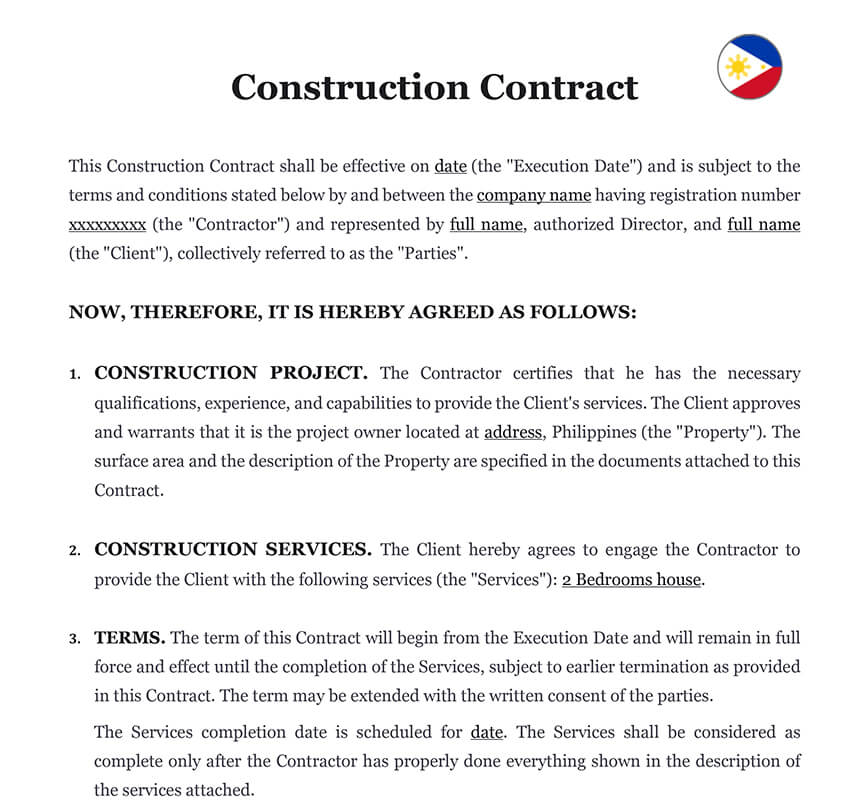A Construction Contract Agreement should be used if you are on either end of the process of building, renovating, or remodeling a building or structure. Perhaps you’ve finally decided to build your dream house and live happily ever after. Due to excessive contractor delays or unanticipated, expensive expenditures, happily ever after may have to wait.
Perhaps you are a local contractor looking to grow your business and take on larger construction projects. In any instance, develop a formal agreement to serve as the blueprint until construction is completed to smooth out the creases.
This agreement allows the parties to specify in writing the type and nature of the work to be done, as well as the responsibilities of each party during the construction process.
Each agreement will be slightly different based on the project, with changes made for scope of work, pricing, and other factors. Most Contract Agreements, however, should have specific parts to safeguard participants on both sides of the agreement.
1. Project description: This section describes the project in depth, including the main idea or explanation of the problem being addressed. It might be a list of items or just a paragraph.
2. Contract price: The sort of contract price that has been awarded, as well as the overall amount of money being contracted, are stated, as are potential contract additions or deductions and how they will be released.
3. Payment basis: This refers to how much money will be paid to the contractor on a weekly, monthly, or milestone basis. This section should also define how much money should be maintained on each payment application. It will also include the due date, the penalty for late payments, if interest is charged, and any other payment and invoicing terms.
4. Calendar or schedule: The total number of days or how the project schedule will be divided should be described as calendar days or business days and can be displayed as a Gantt Chart, bar chart, CPM, or another approach.
5. Construction scope: The scope is a description of all construction operations that will be included in the project that is generally measurable or quantifiable.
6. Construction conditions and obligations: The owner’s and contractor’s responsibilities, including who is accountable for producing paperwork, information, payments, or other deliverables, are put out so that the project may proceed on schedule. It should include explicit language for liens, fines, withholding, and arbitration procedures, as well as directions for processing claims and resolving disputes.
7. List of documents: This section of the contract agreement includes a list of all contract documents. This list may include drawings, exhibits, specifications, and extra conditions.
8. Contract laws: Any applicable legal requirements are mentioned, including governing laws, liens requirements, claims processes, arbitration procedures, insurance, major completion requirements, final completion requirements, and liquidated damages. This may also include methods for terminating or suspending the job, as well as the contract with the contractor.
Before any work can begin, the contract should be signed by both parties. Both parties acknowledge their agreement to the project terms by signing.
If either party violates the terms of the agreement, the contract should describe measures for resolving the issue, including legal action.
If you are constructing, remodeling, or changing a building or structure, you must use a Construction Contract. A Construction Agreement protects both parties. If you’ve recently decided to build your ideal home, a construction contract can protect your rights in the case of extreme construction delays and material shortages, or if your contractor surprises you with unexpectedly high costs. If you’re a contractor, the construction contract will guide you through any unexpected issues that arise before the task is completed.
The Construction Contract allows each party to identify the actual work to be done as well as their respective responsibilities throughout the project. The payment terms of the arrangement are also included in the building contract. All contract terms and conditions must be legally binding.
The Philippines’ construction sector is principally governed by the Construction Industry Association of the Philippines (CIAP), a government organization formed by Presidential Decree No. 1746, series of 1980, as modified (PD 1746). The CIAP is made up of ex-officio members from several executive branches of the Philippine government, including the Secretary of Trade and Industry, the Secretary of Transportation, the Secretary of Public Works and Highways, and the Secretary of Labor and Employment. Furthermore, PD 1746 necessitates the nomination of a representative from the private construction industry to the CIAP.
According to PD 1746, the CIAP’s main functions include developing an overall strategy for the construction industry’s optimal development; monitoring and studying both domestic and international construction industries to identify areas for improvement and to recommend and/or implement changes that support the industry’s development.
The CIAP executes its policies through the Philippine Construction Accreditation Board (PCAB), the Philippine Overseas Construction Board, the Philippine Domestic Construction Board, and the Construction Manpower Development Foundation, which are all under its control.
Aside from the CIAP, local government entities control the construction and repair of buildings and structures within their jurisdictions by assuring compliance with the National Building Code’s basic safety criteria (Republic Act No. 6541). The Housing and Land Use Regulatory Board, on the other hand, regulates the building of condos and subdivisions.
A total set price for all construction-related operations is included in this form of contract. Lump sum contracts may include incentives or rewards for early termination, as well as penalties for late termination, known as liquidated damages.
When the risk must be shifted to the builder and the owner wishes to prevent change orders for specific work, this contract should be employed. A contractor must, however, specify a percentage payment for taking such risk. These expenses will be included in the set pricing. It is more difficult to receive credit for work not done on a lump sum contract, so keep that in mind while weighing your alternatives.
This contract requires payment of the real expenditures, purchases, or other expenses incurred directly as a result of the building activity. Cost plus contracts must include explicit information regarding a pre-negotiated sum (some percentage of material and labor costs) that covers the contractor’s overhead and profit. Costs must be specified and classed as direct or indirect. There are several types of cost plus contracts, the most popular of which are:
When the scope has not been properly specified, cost plus contracts are employed, and it is the owner’s obligation to set certain boundaries on how much the contractor will bill. When some of the aforementioned alternatives are implemented, the incentives will safeguard the owner’s interests and keep them from being paid for unneeded adjustments.
Another sort of contract widely utilized by builders and government bodies is unit price contracts. Unit prices can also be set during the bidding process when the owner asks particular quantities and pricing for a defined number of unitized products.
The owner may readily check that they are being charged uninflated costs for items or services purchased by disclosing unit pricing. During scope adjustments, unit prices may be readily modified up and/or down, making it easier for the owner and builder to achieve an agreement during change orders.
If the project scope is unclear or has not been established, time and material contracts are frequently used. The owner and the contractor must agree on an hourly or daily fee that includes any additional costs that may develop throughout the building process.
Direct, indirect, markup, and overhead expenses must be identified and included in the contract. In order to reduce the owner’s risk, the owner may seek to create a cap or specific project length for the contractor to meet. or when you know how long it will take to finish the scope.





